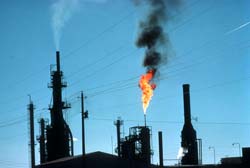Global Pollution Hot Spots Identified

Researchers at the National Center for Atmospheric Research (NCAR) and other institutions have pinpointed the locations of high concentrations of air pollutants around the world by combining data from four satellite imaging systems. Their findings are being presented this week in San Francisco at the annual meeting of the American Geophysical Union (AGU).
The researchers used information from instruments on NASA and European Space Agency satellites to measure atmospheric levels of three types of pollutants that can affect human health: carbon monoxide, nitrogen dioxide, and aerosols. They found especially high concentrations of each over the eastern United States, western and southern Europe, and eastern China, which are among the most heavily industrialized regions in the world.
Steven Massie, an atmospheric chemist at NCAR on the data analysis team, says such satellite images of air pollutants are important for efforts to improve air quality. “As the capability of these imaging systems becomes more and more powerful, the international community will have a way of studying pollution on a global basis and the technical means to monitor emissions from each country,” he explains.
The pollutants vary somewhat by season. In eastern China, for example, urban-industrial emissions of nitrogen dioxide spike during the winter. In the spring, however, aerosol levels are especially high, both because of industrial activities and because of winds that blow in dust from the Gobi and other deserts to the west.
Once airborne, the pollutants often drift eastward and diminish the air quality in neighboring areas. The research, for example, shows that carbon monoxide, nitrogen dioxide, and aerosols from China flow eastward over Japan and the north Pacific Ocean.
Nitrogen dioxide and carbon monoxide are produced largely by industrial activities and vehicle exhaust. Nitrogen dioxide leads to the formation of smog and can irritate the lungs; high levels of carbon monoxide cause a variety of health effects, especially for people with cardiovascular diseases.
Aerosols, or microscopic particles in the air, can cause respiratory ailments as well as reduce visibility and damage buildings. They are associated both with industrial activities and with such natural sources as desert dust and forest fires. Previous research has demonstrated that high aerosol concentrations in nonindustrialized regions over Africa, western China, and eastern Siberia are due to desert dust storms, wildfires, and burning of vegetation for agriculture, home heating, and cooking.
The researchers used four instruments to collect their data. The Moderate Resolution Imaging Spectroradiometer (MODIS), Total Ozone Mapping Spectrometer (TOMS), and Measurements of Pollution in the Troposphere (MOPITT) device take atmospheric readings from aboard NASA satellites; the Global Ozone Monitoring Experiment (GOME) is a spectrometer on the second European Remote Sensing Satellite. MOPITT is a joint project of NCAR and the Canadian Space Agency.
In addition to NCAR, the research team includes scientists from NASA Goddard Space Flight Center and the University of Bremen in Germany.
Media Contact
All latest news from the category: Ecology, The Environment and Conservation
This complex theme deals primarily with interactions between organisms and the environmental factors that impact them, but to a greater extent between individual inanimate environmental factors.
innovations-report offers informative reports and articles on topics such as climate protection, landscape conservation, ecological systems, wildlife and nature parks and ecosystem efficiency and balance.
Newest articles

High-energy-density aqueous battery based on halogen multi-electron transfer
Traditional non-aqueous lithium-ion batteries have a high energy density, but their safety is compromised due to the flammable organic electrolytes they utilize. Aqueous batteries use water as the solvent for…

First-ever combined heart pump and pig kidney transplant
…gives new hope to patient with terminal illness. Surgeons at NYU Langone Health performed the first-ever combined mechanical heart pump and gene-edited pig kidney transplant surgery in a 54-year-old woman…

Biophysics: Testing how well biomarkers work
LMU researchers have developed a method to determine how reliably target proteins can be labeled using super-resolution fluorescence microscopy. Modern microscopy techniques make it possible to examine the inner workings…





















